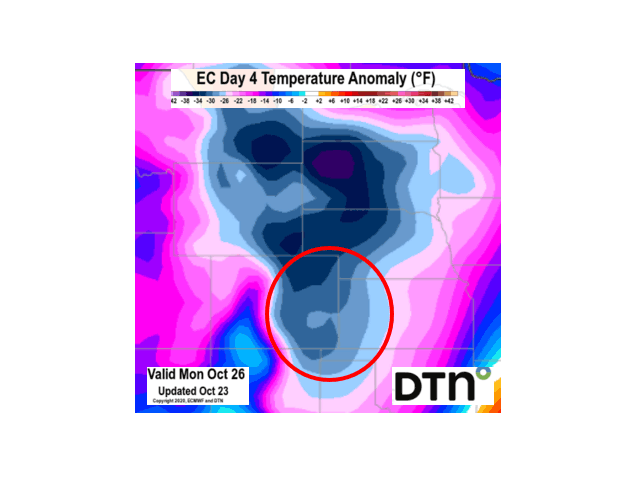Bitter Cold Ahead
Deep Freeze Forecast This Weekend Could Endanger Wheat, Stall Harvest
ROCKVILLE, Md. (DTN) -- Wheat, it's about to get cold out there.
That's the warning from DTN Senior Ag Meteorologist Bryce Anderson, who said parts of the Great Plains and northern Midwest will see a bitterly cold front move through Saturday, Oct. 24 into Monday, Oct. 26.
"The next week brings more of that cold, stormy pattern into the northern Rockies, Northern Plains and northern Midwest and will extend south into the southwestern Plains," he said.
Moisture from this cold front is expected to stall corn and soybean harvest, and the frigid temperatures it will bring could endanger newly planted winter wheat in the Great Plains.
"Overnight low temperatures Sunday into Monday will drop to near zero in the Northern Plains and into the single digits in northwestern Kansas," Anderson predicted. "Temperatures will be at least 20 degrees below normal, and we could see quite a few record lows recorded."
Of the winter wheat growing regions, Kanas and Colorado are slated to see the most bitter cold, he added, "Northwest Kansas to eastern Colorado area is the most prone for bitter cold when it comes to wheat damage potential."
Some of the winter wheat in Kansas may have experienced enough cool fall weather to start the long process of winterizing itself, noted Jeanne Falk Jones, an extension agronomist with Kansas State University.
"That cold acclimation process starts around the 50-degree mark at the crown root level; that's when the plant starts putting an antifreeze-like substance into its leaves to protect it from the from cold temperatures," she said.
P[L1] D[0x0] M[300x250] OOP[F] ADUNIT[] T[]
But that acclimation process is a long one, Falk Jones noted. And newly emerged wheat will be more vulnerable, especially given the single digits forecast for parts of northern and western Kansas, added Romulo Lollato, extension wheat and forages specialist for Kansas State. "That could cause damage to plants that just emerged," he said. "They are not as cold hardy and will be sensitive to those cold temperatures."
And all wheat is struggling with the reality that the Southern Plains has been slipping farther into drought conditions this fall.
"USDA now estimates that 48% of U.S. winter wheat area was under drought conditions as of Tuesday, up from 41% last week and just 12% a year ago -- the highest for this time of year since 2012," Anderson said. "Kansas wheat is 53% in drought compared with just 23% last week."
As a result, many winter wheat stands in Kansas have been spotty in their emergence and vigor, Falk Jones and Lollato said.
Growers who were able to plant their winter wheat in mid-to-late September captured some of the last moisture the state has seen, and were able to get emerged and tillering fields, said Lollato. Wheat planted after early October has not fared as well.
"The crop is very variable," Lollato said.
"We know that when we have dry soils, temperatures can fluctuate more in the soil," Falk Jones added. That means the severely cold air temperatures could endanger some crown roots that are currently sitting in 40- to 60-degree soils.
In some cases, wheat has yet to emerge, as the seeds haven't had the moisture necessary to germinate, she added. While winter wheat planting in Kansas has raced ahead of the five-year average to reach 84% completed as of Monday, only 61% of the crop had emerged, according to USDA NASS crop progress reports. In Colorado, winter wheat planted had nearly wrapped up by Monday, at 98% planted, with 68% emerged.
The unemerged seeds could weather the freeze fine if they haven't germinated in their wait for moisture, Falk Jones said. But if they have germinated and have just not emerged, their crown roots could still be at risk of freeze damage, especially if they are shallowly placed, she added.
A lot will hinge on how much moisture comes along with this cold front, Falk Jones and Lollato concluded.
"At least an inch of a snow layer would be needed to help buffer the very cold temperatures," Lollato said. "Below that snow layer, temperatures will be in the 30s, so that helps buffer colder air temperatures."
Kansas growers can get estimates of their soil temperatures at 2 and 4 inches through the Kansas Mesonet, which can help them evaluate freeze damage risks as this cold snap unfolds, Falk Jones said.
See the Mesonet's soil temperature page here: https://mesonet.k-state.edu/…
In addition to wheat risks, some of the corn and soybean crop in the northern Midwest is still waiting on the combine; the forecast precipitation from this cold front will likely interfere, Anderson added.
"I think that snow in the Dakotas and Minnesota and rain from eastern Nebraska east, along with below normal temps will slow down harvest of that last 40% of the U.S. corn crop," he said.
See more from the DTN weather page here: https://www.dtnpf.com/…
Emily Unglesbee can be reached at Emily.unglesbee@dtn.com
Follow her on Twitter @Emily_Unglesbee
(c) Copyright 2020 DTN, LLC. All rights reserved.






